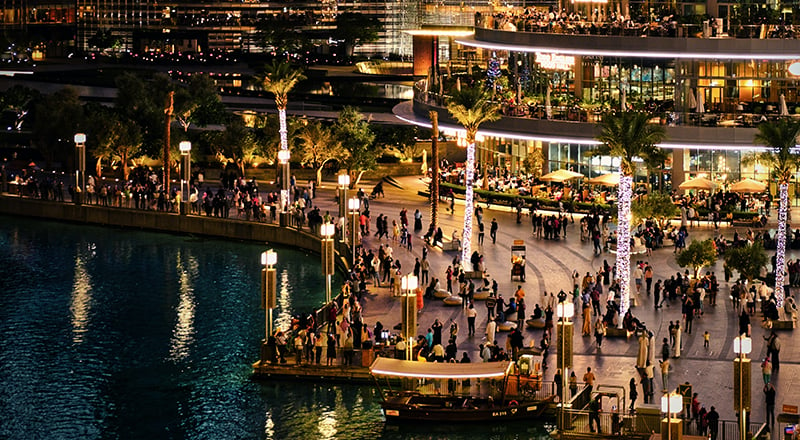People live in Dubai — that’s the question many ask as this desert city transformed into a global hub. As of mid 2025, estimates suggest that about 3.95 million people live in Dubai, making it the most populous emirate in the UAE. This article explores the latest figures, demographic patterns, and future population trends.
How Many People Live in Dubai (2025 Figures)
As of June 2025, Dubai’s population stands at approximately 3.95 million residents. This marks steady growth compared to previous years, reflecting a surge in employment opportunities, immigration policies, and overall urban development.
Dubai’s population has increased by over 100,000 in the first half of the year alone. These numbers continue to rise as more people are drawn by job prospects, better living standards, and international connectivity.

Who Lives in Dubai? Demographic Breakdown
Gender ratio
Dubai’s population is predominantly male, with men making up about 68.6 percent of the total population. Women account for around 31.4 percent. This imbalance exists largely due to the influx of male expatriate workers in construction, logistics, and other labor intensive industries.
Age structure
Most of Dubai’s residents are working age adults, particularly between 25 to 54 years old. This group forms the backbone of the city’s economy. Children and teenagers (0 to 14 years) make up about 14.8 percent of the total population, while seniors above 60 are a much smaller segment.
Nationals vs expatriates
Roughly 92 percent of people who live in Dubai are expatriates, while only about 8 percent are Emirati nationals. Dubai is one of the most internationally diverse cities in the world, with residents from over 200 nationalities.
Common nationalities
The largest communities include people from South Asia (India, Pakistan, Bangladesh), the Philippines, Egypt, Iran, and various Western countries. This diversity shapes Dubai’s culture, food, and social life in vibrant ways.
What Drives Dubai’s Population Growth
Dubai’s population has more than doubled in the last two decades. Several key factors contribute to this rapid expansion:
- Job opportunities. The city’s thriving sectors like real estate, hospitality, finance, and logistics attract a global workforce.
- Business friendly policies. Dubai offers tax incentives, free trade zones, and global connectivity, making it a magnet for entrepreneurs.
- Liberal immigration policies. With long term and golden visas, Dubai welcomes skilled professionals and investors.
- Global events. Major international events like Expo 2020, along with cultural festivals and sports events, boost visibility and draw interest.
All these aspects make Dubai a top destination not just for tourists, but also for those seeking to live and work long term.
Life in a Rapidly Growing City
As more people live in Dubai, the city faces new challenges in maintaining quality of life, housing, and infrastructure.
Housing costs
Dubai has seen significant increases in housing demand. Rent prices have surged in recent years, especially in central and waterfront areas. This puts pressure on low and middle income residents to find affordable accommodation.
Shared housing
Some workers, especially in labor intensive sectors, reside in shared spaces to manage living costs. Authorities have introduced regulations to improve safety and living standards in densely occupied buildings.
Public services and transport
With population growth, the demand for schools, hospitals, public transport, and utilities has increased. Dubai has responded by expanding its metro network, upgrading public buses, and encouraging the use of electric and smart mobility solutions.

Urban vs Metro Area Population
The Dubai city and emirate proper house approximately 3.95 million people. However, the larger Dubai Sharjah Ajman metropolitan region includes more than 6.3 million residents. Many people working in Dubai live in neighboring emirates and commute daily.
This interconnected metro zone shows how Dubai’s influence extends beyond its borders, forming one of the most dynamic urban clusters in the Middle East.
Future Projections: What Lies Ahead
If growth trends continue, Dubai’s population is expected to reach around 4.6 million by 2030. Longer term forecasts even suggest the figure could approach 5.8 to 6 million by 2040, depending on economic development and migration policies.
Dubai’s government has launched a strategic urban plan with the goal of becoming one of the top 10 cities in the world by population, livability, and global influence. This includes:
- New residential developments
- Green and smart city infrastructure
- Investment in education, healthcare, and innovation
These initiatives aim to attract more families and long term residents, not just temporary workers.
Key Points to Remember
- As of mid 2025, about 3.95 million people live in Dubai.
- The city’s population is mostly male (68.6 percent) and expatriate (92 percent).
- Dubai continues to grow due to its global job market, infrastructure, and lifestyle.
- Living costs, particularly housing, remain a challenge in some areas.
- The broader metropolitan area includes over 6.3 million people.
- By 2030, Dubai may reach 4.6 million residents or more.
Final Thoughts
If you have ever wondered how many people live in Dubai, the answer in 2025 is nearly 4 million. Among them, most are expatriates from around the world, shaping Dubai into a cosmopolitan city like no other. Whether for work, business, or lifestyle, Dubai remains one of the world’s most attractive places to live.
As the skyline rises and communities grow, Dubai continues its journey from a desert port to a global city shaped by the people who choose to call it home.
Do follow UAE Stories on Instagram
Read More: Dubai Fine Traps: 8 Everyday Mistakes You Don’t Realise













